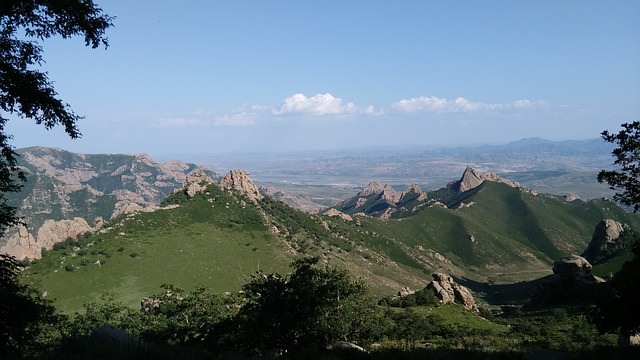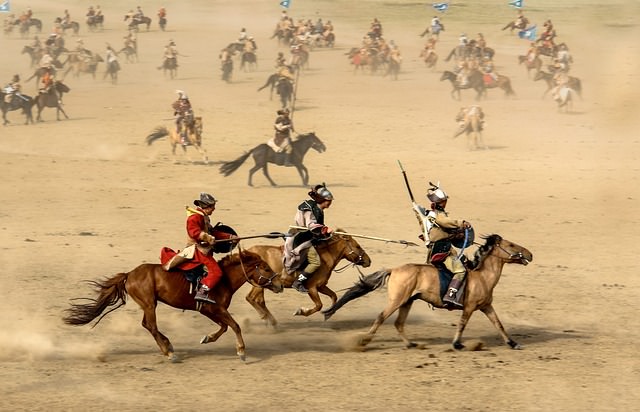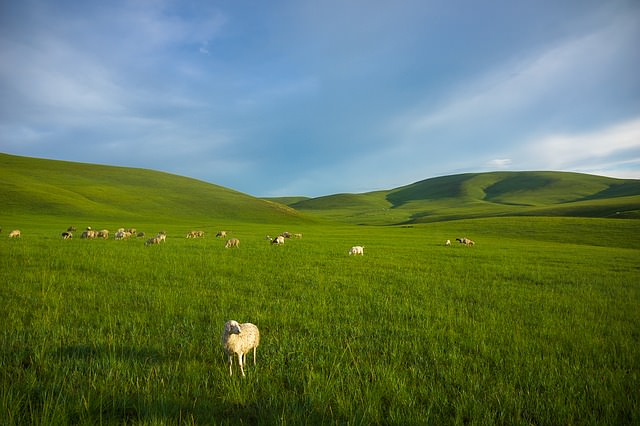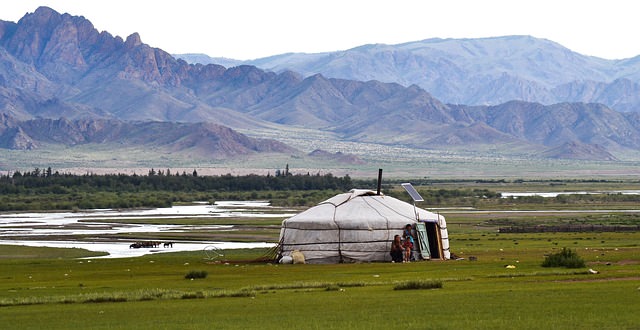Backpacking in Mongolia
Only China and Russia surround Mongolia, but the country is gigantic. And even more gigantic is the nothing in Mongolia – at least as far as the number of inhabitants is concerned. Hardly any country on the globe is more sparsely populated. Just 1.7 inhabitants per km² live on a land area of 1,564,116 km² (for comparison: the area of Germany is 357,340 km²). While more than 82 million people live in Germany, there are just over 2.7 million – a lot, a lot of space.
In Mongolia you can really let off steam as a backpacker. Race across the endless grass steppes on the tough ponies or cross the country with the native nomads. Freedom and adventure – nowhere do these two words have more meaning. Although it is often bitterly cold in Mongolia, the country can come up with one of the highest sunshine quotas at all. In the so-called “land of the blue sky”, the sun shines on an average of 250 days. Take a good sunscreen with you.

Backpacking in Mongolia – daqingshan
Traveling is not that easy and traveling is not cheap either, despite the fact that it is a kind of developing country. Especially not if you have to hire guides, travel companies or agencies for trips. Otherwise, you will make ends meet quite cheaply. But only if you do without comfort. A bed in a dorm costs about 8 to 10 Euro per night, which is quite steep.
You should also be careful when it comes to safety. You are not travelling in Switzerland. Who thinks of renting a car or a motorcycle should know that Kamikaze is not an unknown term there. An old rule says: The fatter the vehicle, the safer the transport. If you don’t want to stress about travelling – staring 20 hours into the prairie can be hard – take a domestic flight.
You can only get money from ATM machines in the larger cities. That is no problem, because there is not much to spend in the interior of the country. You don’t need to hope for exotic Asian delicacies with juicy fruits and sweet and sour sauces. The Mongolians, who speak their own language, the Mongolian, by the way, like meat very much. Sheep and beef are on the menu. The locals don’t believe in agriculture at all. How is that supposed to work as a nomad?
What should you have seen in Mongolia?
In Erdenet, the second largest city in the country, you can have a look at the carpets. More interesting is the historical city of Hovd, which forms a cultural link between the Mongols and the Kazakh culture. It is worth taking a look at the Altai Tavan Bogd National Park. A fascinating mountain splendour and the largest glaciers await you. Lake Uvs Nuur is a World Heritage Site. You have to take a trip to the famous Gobi Desert in Gurvan Saikhan National Park. Also spectacular are the Khongor sand dunes and the Yol Cañon.

Backpacking in Mongolia – Culture
Culture in Mongolia
For the Chinese, the Mongols were barbarians – but who isn’t for the Chinese? Probably they were also afraid of the Huns, who invaded the Middle Kingdom over and over again. At some point, however, they simply changed direction and advanced west. What then came is still known today under the Hun storm. Mongolia is as big as Alaska. About 56 million sheep, goats, cattle, horses and camels live in Mongolia. It is therefore much easier to meet a four-legged friend than a two-legged friend.
Especially since 40 percent of the 2.7 million inhabitants have settled in the capital Ulan Bator. You meet a very young population. More than 70 percent are younger than 35 years. In terms of religion and belief, more than 90 percent are attached to Tibetan Buddhism and pagan Shamanism. What the Mongols can do better than others is wrestling, riding and archery. If you don’t want to believe it, you go to the famous Naadam Festival, where the best compete in sports.
Backpacker Route in Mongolia
Travelling in Mongolia is difficult, because often huge distances have to be bridged. There are certainly some very interesting spots, but getting there can take some time. You should also keep an eye on the travel times, because it gets bitterly cold very quickly and then sometimes nothing works anymore. What should you have seen?
Route 1: The classic (15-20 days)
- 2 days to visit the capital Ulan Bator
- 2 days to get to know Erdenet with its copper mines and carpet shops
- 2 days Khorgo-Terkh National Park with Terkhiin Tsagaan Lake
- 2 days Naiman Nuur or the 8 lakes near the Orkhon waterfall. The lakes are remnants of the many volcanic eruptions and earthquakes. All are part of the Khuisiin Naiman Nuur nature reserve.
- 3 days Gobi Desert – Visit to Gobi Gurvan Saikhan National Park.
- 2 days Mörön to explore the capital of the Hövsgöl province.
- 2 days exploring Kazah culture in Ölgii in the far west of Bayan-Oelgii Province
- 2 days Karakorum to get to know the former capital built by Genghis Khan
Route 2: Backpacker Intensive Trip (up to 40 days and more)
- 2 days to visit the capital Ulan Bator
- 2 days to get to know Erdenet with its copper mines and carpet shops
- 2 days Khorgo-Terkh National Park with Terkhiin Tsagaan Lake
- 2 days Naiman Nuur or the 8 lakes near the Orkhon waterfall. The lakes are remnants of the many volcanic eruptions and earthquakes. All are part of the Khuisiin Naiman Nuur nature reserve.
- 3 days Gobi Desert – Visit to Gobi Gurvan Saikhan National Park.
- 2 days Mörön to explore the capital of the Hövsgöl province.
- 2 days exploring Kazah culture in Ölgii in the far west of Bayan-Oelgii Province
- 2 days Karakorum to get to know the former capital built by Genghis Khan
- 2 days visiting Tavan Bogd National Park with peaks up to 4770 m high
- 3 days visiting the Bogd mountain world with the Altayn, Hangayn and Khenteynrang mountain ranges
- 1 day bizarre rocky landscape Tsagaan Suvarga
- 1 day former dinosaur home Bayanzag
- 2 days former capital Kharkhorin on the former Silk Road with its monastery complexes
- 2 days Orkhon valley with magnificent mountains. The valley is part of the world natural heritage.
Travel times in Mongolia
The travel times for backpacker wimps are short in Mongolia. The best time is from May to the end of August. Then you’ll have to dress warm again. You have nice weather despite the bitter cold, which on average lies between day temperatures of -25 °C in winter and +20 °C in summer, nevertheless, mostly. On 250 days a year you can enjoy a bright blue sky. The advantage of a Backapcker tour in spring and autumn is that you will not meet many other visitors.
This can also have an effect on the prices. If you want to come in winter, you can hope that you won’t experience any Dsud. Dsuds are extremely snowy winters. There are different Dsuds at the same time, among them the black, white and ice Dsud. They all have certain characteristics. Sometimes the wells freeze over, sometimes the animals find nothing to eat because of the high snow cover and sometimes the ground freezes over. However, it rarely rains. In the Gobi desert less than 100 ml of rain falls.
Backpacker Budget in Mongolia
Traveling in Mongolia is not quite as inexpensive as in many Southeast Asian countries. But also not overly expensive. The local currency is the Tögrög. Calculated times 1 EUR = 2160 MNT. During your backpacking tour you can assume that the cost of living in Mongolia is about 25 percent cheaper than in Cologne. This is especially true in comparison to the capital Ulan Bator. A bed in a dorm can cost between 8 and 12 euros. A double room in a guesthouse will cost you between 17 and 40 Euros.
It’s worth thinking about it already. The food is strong – not to say very strong – and costs between 2 and 6 Euros per meal in a simple restaurant. If you want middle class or first class comfort, which there is, then the prices will increase accordingly. Such a riding tour with all the trimmings, for example 2-3 days in the Gun-Galuut National Park, can already cost 400 euros. For riding tours, which last 12 days, the price is about 2500 Euro. If you want to go on a tour with the all-wheel drive, you have to pay 120 Euro a day.
Bus driving in Mongolia
Mongolia is a bus country. But unfortunately you don’t always see that on the vehicles. Nevertheless you come everywhere with the long-distance buses. As price orientation you can take 17 to 20 Euro for a distance of 650 km as a basis for your backpacker tour. Cash payment only with ticket purchase.
Domestic fares in Mongolia
Flying is the fastest option to get from A to B. You can see the prices of the national airlines on the homepages of MIAT Mongolian Airlines, Aero Mongolia, Eznis Airways and Hunnu Air .
Train travel in Mongolia
The rail network in Mongolia has a length of 1800 km. You can take the Transmongolian Railway across the country from the Russian to the Chinese border. There is then a connection to the Trans-Siberian Railway. You will pass through all major cities of the country.
Go by ship
There would be enough possibilities. After all, more than 1200 rivers with a length of almost 70,000 km cross Mongolia. Stupidly only that these are frozen for months.
By bike
Backpackers who want to explore Mongolia by bike can rent or buy a machine for 10 euros a day.
Backpacker Accommodation in Mongolia
Although the country does not have a flourishing tourism industry, you can stay overnight in any type of hostel. Small but nice is what Mongolia has to offer in terms of accommodation. There is a suitable accommodation for every budget and every taste. From the simple hostel bed over inexpensive 2 star hotel rooms up to the fashionable 5 star hotels the offer extends. Even guesthouses in the Mongolian steppe can be found. For a room in a good 4 star hotel you have to calculate about 80 Euro.
At the 5 star hotels there are room prices from 80 Euro upwards. It may even be that you pay more for a 3 star hotel room than for a room in a Five Star Hotel. Everything is quite opaque, therefore a comparison on the spot is worthwhile. Hostels are only found in the larger cities. For a bed in a Hosteldorm you have to plan your backpacker stay around 7 Euro. There are already beds for 4 Euro. The bed in a Mongolian steppe guesthouse costs around 5 Euro.
Bed and Breakfast are rather less known. Options offers meanwhile also the well-known private room mediators. Depending on location and equipment this can be a good solution. Airbnb and 9flats are contact points on the World Wide Web to browse for cheap private rooms or whole apartments. In the riding tours the overnight stays are included, as far as it concerns multi-day rides. However, the tours are not quite cheap. A 3-day complete riding tour already costs around 400 euros. Everything included.
Camping in Mongolia
You can camp almost everywhere in Mongolia. You are in a real camper country at your backpacker Tripp. After all, the real Mongolians still live like thousands of years ago in their yurt tents. Camping is free. There are enough places above all at the countless lakes and rivers which are spread all over the country. But it is better to visit the registered campsites in the national parks. Purely for reasons of your own safety.
Backpacker Trips, Tips & Highlights in Mongolia
Discovering Mongolia means coming into close contact with nature, because you won’t get much distraction from people on your backpacking trip, because there are hardly any. A backpacking trip to Mongolia includes a visit to the Terelj National Park, where you will also meet the magnificent Genghis Khan statue. During a side trip to the huge Hustai National Park you will meet the Takhi. This is the name of the Mongolian wild horses that still hunt freely through the steppes. The Erdene-Zuu monastery, which dates back to 1586, is certainly also impressive. You can experience more adventure on a boat trip on Ugii Lake, which is located at an altitude of 1387 m and is 25 km2 in size. A variety of birds have settled there.

Backpacking in Mongolia – Landscape
Backpacker Highlights in Mongolia
One of the backpacker highlights in Mongolia is certainly a visit to Elsen tasarkhai, where a bizarre dune landscape has formed over the millennia. A camel tour is the best way to get to know the region. In the summer you can explore one or more of the 1200 rivers of the country or one of the 4000 lakes on homemade loes or canoes. You can even sail a saltwater lake, the Uws Nuur. The best thing about the lakes is their purity. There is hardly any industrial pollution. No visit to Mongolia without a riding tour. Do it like the nomadic people and rush with the tough ponies over the endless grass steppes.
But attention! You need a good seat, because the Mongolians ride on wooden saddles. If you’re looking for a praiseworthy souvenir in the country, take a look at the textiles made of cashmere wool, which belong to the best and finest that the world knows. If you want to take more with you, you can also choose one of the fantastic woven carpets. To get to know the country on your own, it’s best to rent a jeep or a motorcycle. The backpacker discovery tour will be even cheaper if you resemble the real nomads and explore the country on foot. However, this can take some time with the gigantic distances.
Backpacker insider tips in Mongolia
Mountain climbing in the Altai Mountains is one of the insider tips for hardcore backpackers. There you will also meet the Kazakh eagle hunters. This rare species of hunters, which is supported by the large birds of prey, lives in the Altai Tavan Bogd National Park. The hardest among you don’t visit Mongolia in summer, but in winter, when all the other wimps tourists have long since gone far because of the extreme weather conditions. Spending time in a yurt with freezing temperatures outside and cold winds that penetrate to the marrow with the Mongolians at the fire far away from any civilization is probably one of the last adventures on the planet.

Backpacking in Mongolia – Yurt
Food & Drink in Mongolia
Vegans, vegetarians and all other backpackers who don’t like meat and dairy products have bad cards. These are the main sources of food for the nomadic people. How is a nomad supposed to farm laboriously when he travels through the endless steppes with his huge herds of cattle all year round?
Food in Mongolia
Everything that has fur is eaten. From sheep and goats to cattle and camels. Also what the horses and the yaks give away is prepared in some way. The meat is boiled, cooked, grilled or dried. And the Mongols don’t do that with charcoal. It would be much too costly and tedious to produce them. The nomads don’t need them either, because the livestock produces manure. And once it has dried, it burns very well. Cooked sheep meat is particularly popular. And that without large side dishes.
Very tasty are the buuds, which are offered at many street stalls in the big cities. During your backpacking tour, you bite into meat-filled dumplings that are cooked in steam. The locals do not use vegetable oil for frying, but sheep fat. If you don’t like meat at all, you can eat the side dishes rice or fresh noodles. You should definitely try mutton soup with Bansch, Boortsog, Aaruul, Airag, Chorchog and beef on noodles. In the big cities, you can also get your belly full in the well-known fast food chains.
Drinking in Mongolia
Of course, Mongolians also know alcohol. The national drink is Airag, which is made from fermented milk. The drink cannot necessarily be described as high-proof, but it has an effect. Milk tea is also a popular drink, which is offered to you also gladly with a visit in a private household. Like the milk of the Mongolians at all, water, wine or beer belong on the dinner table just as they do with other peoples.
Those who want to get it with harder “stuff” can enjoy the local vodka. Brands such as Chinggis Khaan, Soyombo or Golden Chinggis are well known and provide for a long intoxication at a reasonable price. All beer cows should stock up in the big cities with the well-known imported beers from the west, because outside they no longer exist. Local beers like Chingiss and Gem Grand are quite enjoyable and much cheaper.
Backpacker Visa and Vaccinations in Mongolia
The website of the Foreign Office will reliably show you which travel documents you need for your backpacker trip to Mongolia. The good news right from the start. Since September 1, 2013, you as a German citizen no longer need a visa to enter Mongolia for a short-term visit of a maximum of 30 days. You can enter Mongolia with the following documents:
- Passport: Yes
- Provisional Passport: Yes
- Identity card: No
- Temporary identity card: No
- Children’s passport: Yes
- Still valid child ID card according to old model: No
Comments
The child entries in the passport of the parents are no longer valid. All children who want to enter the country need their own identification document. It is important that the documents are valid for at least another six months. If you want to stay longer than 30 days, you must obtain a visa at the embassy.
Medical information
You should definitely have the usual vaccinations against tetanus, diphtheria, polio, measles, rubella and flu. Those who want to stay longer in the country should also be vaccinated against hepatitis A, hepatitis B, TBE, typhoid fever and rabies. Tuberculosis is well known in Mongolia, as is hand, foot and mouth disease (HFMD). You should also beware of the early summer meningoencephalitis (FSME)+ RSSE (Russian Spring Summer Encephalitis), which keeps breaking out. Brucellosis is transmitted by sick animals. Even anthrax and the plague are known. In addition, good medical care is not guaranteed everywhere.
